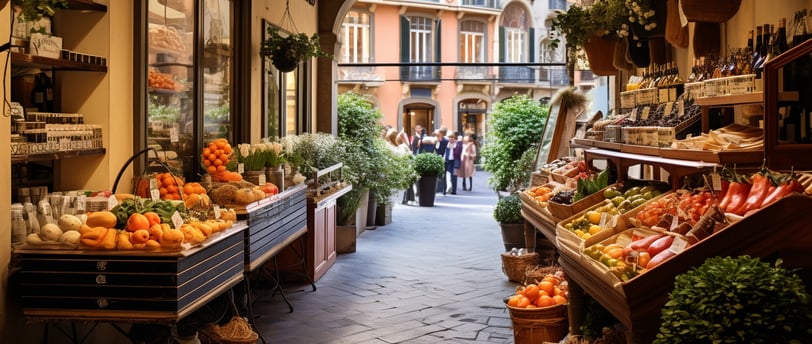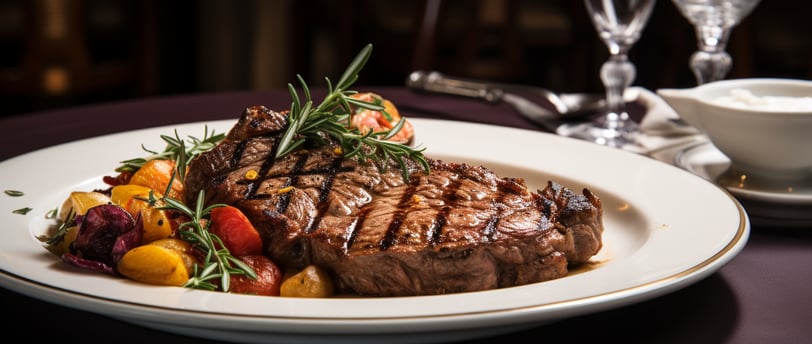Florence's Culinary Scene: A Fusion of Art and Flavor
Dive into a world where art meets flavor in Florence, experiencing a culinary scene that paints every plate with the rich palette of Tuscan tradition and innovative zest.

Florence, the birthplace of the Renaissance, is renowned for its incredible art and architecture. But did you know that the city's culinary scene is just as impressive? Florence's cuisine is a fusion of art and flavor, with a rich history and a modern twist. From traditional dishes that date back centuries to innovative fusion creations, Florence offers a truly unique dining experience.
The Historical Influence on Florence's Cuisine
One cannot understand Florence's culinary scene without delving into its rich history. The Renaissance period played a crucial role in shaping the city's food culture. During this time, Florence became a hub of cultural and intellectual activity, attracting artists, writers, and scholars from all over Europe. The exchange of ideas and knowledge also extended to food, resulting in the development of unique cooking techniques and flavor combinations.
One of the most prominent figures of the Renaissance period in Florence was Caterina de' Medici. Born in Florence in 1519, Caterina later became the Queen of France. Her influence on French cuisine is well-known, but her impact on Florence's culinary scene is often overlooked. Caterina brought with her a team of Italian chefs who introduced new ingredients and cooking methods to the French court. These culinary innovations eventually made their way back to Florence, enriching the city's gastronomic landscape.
Furthermore, Florence's geographical location has had a significant impact on its cuisine. Situated in the heart of Tuscany, the region is known for its abundance of fresh, high-quality ingredients. From the fertile valleys that produce exceptional produce to the lush hills that are home to grazing animals, Florence has access to a diverse array of ingredients that form the foundation of its traditional dishes.
Let's explore the Tuscan countryside surrounding Florence, where the region's culinary treasures are cultivated. The Chianti region, famous for its vineyards and rolling hills, is known for producing some of Italy's finest wines. The Sangiovese grape, a key component of Chianti wines, thrives in this area's unique microclimate. The wine's distinctive flavors and aromas are often incorporated into traditional Florentine dishes, adding depth and complexity to the cuisine.
Not far from Chianti lies the Val d'Orcia, a UNESCO World Heritage site. This picturesque valley is home to fields of golden wheat, which are transformed into the region's beloved pasta. From pici, a thick and chewy hand-rolled pasta, to tagliatelle, a delicate ribbon-like pasta, the Val d'Orcia's wheat fields provide the raw material for these culinary delights. The pasta is often paired with rich meat sauces, such as wild boar ragu or duck ragu, creating hearty and satisfying dishes.
Heading towards the coast, we find the Maremma region, known for its pristine beaches and rugged landscapes. This coastal area is a seafood lover's paradise, offering an abundance of fresh fish and shellfish. From succulent prawns to tender octopus, the Maremma's coastal waters provide a bountiful harvest for Florentine chefs. These seafood delicacies are often prepared simply, allowing the natural flavors to shine through.
As we venture back to the city of Florence, we cannot ignore the influence of the Medici family on its cuisine. The Medici were not only patrons of the arts but also avid food enthusiasts. They commissioned lavish banquets and feasts, where the finest ingredients were showcased in elaborate dishes. The Medici's love for opulence and indulgence left an indelible mark on Florence's culinary traditions, with dishes like bistecca alla fiorentina, a thick and juicy T-bone steak, becoming synonymous with the city.
In conclusion, Florence's cuisine is a reflection of its rich history and geographical location. The Renaissance period brought new ideas and techniques to the city, while the abundance of fresh ingredients from the surrounding Tuscan countryside provided the building blocks for traditional Florentine dishes. From the influence of Caterina de' Medici to the flavors of Chianti and the seafood of the Maremma, Florence's culinary scene is a tapestry woven with history, culture, and gastronomic delights.
The Artistic Side of Florence's Food Scene
Just as art is valued for its visual appeal, so too is the presentation of food in Florence. The aesthetics of plating are given utmost importance in the city's restaurants. Dishes are meticulously arranged, with vibrant colors and elegant designs that resemble a work of art. Each plate is a masterpiece that pleases the eye as well as the palate.
Color and texture are also crucial elements in Florentine cuisine. From the bright red of ripe tomatoes to the varied textures of different cuts of beef, Florence's dishes are a sensory delight. The combination of flavors and textures creates a harmonious balance that is characteristic of the city's cuisine.
When it comes to plating, Florentine chefs take inspiration from the Renaissance art that the city is renowned for. Just as the great artists of the past carefully composed their paintings, chefs in Florence meticulously arrange each element on the plate. They pay attention to every detail, ensuring that the colors, shapes, and textures complement each other, much like the brushstrokes on a canvas.
One popular technique used by Florentine chefs is the concept of "painting" with sauces. They skillfully drizzle vibrant sauces onto the plate, creating intricate patterns that add both visual interest and flavor to the dish. This technique not only enhances the overall presentation but also allows the diner to experience a burst of flavors with each bite.
In addition to the visual appeal, Florentine cuisine also pays homage to the city's rich history and cultural heritage. Traditional dishes often feature ingredients that have been used in the region for centuries, such as Tuscan olive oil, pecorino cheese, and balsamic vinegar. These ingredients not only add depth of flavor but also reflect the deep-rooted culinary traditions that have been passed down through generations.
Furthermore, the attention to detail in Florentine cuisine extends beyond the plating. Chefs in Florence take great care in selecting the freshest and highest quality ingredients. They source locally and seasonally, ensuring that each dish showcases the flavors of the region at their peak. This commitment to quality is evident in every bite, as the flavors are vibrant and the ingredients shine through.
When dining in Florence, it is not just a meal but a sensory experience. The artistic presentation, the harmonious flavors, and the rich history all come together to create a truly memorable dining experience. Whether you are indulging in a classic Florentine steak or savoring a plate of handmade pasta, each bite is a celebration of the culinary artistry that Florence has to offer.

The Flavor Profile of Florentine Cuisine
The flavor profile of Florentine cuisine is a testament to the city's commitment to using fresh, local ingredients. Florence prides itself on its farm-to-table philosophy, with restaurants sourcing their produce from nearby farms and markets. This emphasis on freshness ensures that each dish bursts with flavor, as the natural taste of the ingredients shines through.
In traditional Florentine dishes, simplicity reigns supreme. Classic dishes such as Bistecca alla Fiorentina, a thick-cut grilled steak, and Ribollita, a hearty vegetable and bread soup, showcase the quality of the ingredients without overpowering flavors. It is all about allowing the natural flavors to speak for themselves.
Let's delve deeper into the flavor profile of Florentine cuisine. One cannot discuss Florentine cuisine without mentioning the famous Tuscan olive oil. The region's olive groves produce some of the finest olive oils in the world, known for their rich and fruity flavors. This golden elixir is a staple in Florentine cooking, adding a luscious and distinctive taste to dishes.
Another key component of Florentine cuisine is the use of fresh herbs. The region's fertile soil and temperate climate provide the perfect conditions for growing a variety of aromatic herbs, such as rosemary, sage, and thyme. These herbs are used generously in Florentine dishes, infusing them with fragrant and earthy flavors.
One cannot discuss the flavor profile of Florentine cuisine without mentioning the region's love affair with cheese. Florence is home to some of Italy's most renowned cheese varieties, including the creamy and delicate Pecorino Toscano and the sharp and nutty Parmigiano-Reggiano. These cheeses are often grated or shaved over dishes, adding a rich and savory element to the overall flavor profile.
Furthermore, Florentine cuisine is known for its love of simplicity and balance. The dishes are not overly seasoned or heavily spiced, allowing the natural flavors of the ingredients to shine through. This approach highlights the quality and freshness of the produce, creating a harmonious and well-rounded flavor profile.
Lastly, Florentine cuisine embraces the concept of "cucina povera," which translates to "poor cooking." This style of cooking originated from the necessity to make the most out of humble ingredients. It is characterized by dishes that are hearty, filling, and full of flavor. The use of ingredients such as beans, kale, and stale bread in dishes like Ribollita and Pappa al Pomodoro exemplify this approach, resulting in dishes that are both comforting and satisfying.
In conclusion, the flavor profile of Florentine cuisine is a celebration of simplicity, freshness, and the natural flavors of the ingredients. From the rich and fruity Tuscan olive oil to the aromatic herbs and exquisite cheeses, each element contributes to a harmonious and well-rounded culinary experience. Whether you are savoring a perfectly grilled Bistecca alla Fiorentina or indulging in a bowl of hearty Ribollita, Florentine cuisine is sure to leave a lasting impression on your taste buds.
The Modern Fusion in Florence's Culinary Scene
While Florence is steeped in tradition, the city's culinary scene also embraces innovation and fusion. The influence of global cuisine can be seen in the diverse range of restaurants that have opened in recent years. From sushi bars to Indian eateries, Florence offers a wealth of options for those seeking a taste of the world.
Fusion restaurants, in particular, have risen in popularity, blending traditional Florentine flavors with international ingredients and techniques. These establishments push the boundaries of what is possible and create exciting new flavor combinations that tantalize the taste buds.

The Future of Florence's Culinary Scene
As Florence looks towards the future, sustainability is becoming an increasingly important aspect of the city's food culture. Restaurants are embracing eco-friendly practices, such as sourcing organic and locally sourced ingredients, reducing food waste, and supporting local farmers and producers. An awareness of the impact of food choices on the environment is shaping the way Florence eats.
Technology is also playing a role in the evolution of Florence's culinary scene. From online reservation systems to innovative kitchen equipment, technology is streamlining operations and enhancing the dining experience. Digital platforms are connecting diners with the city's vibrant food scene, making it easier than ever to discover new restaurants and culinary experiences.
The Timeless Charm of Florence's Culinary Scene
With its blend of rich history and modern innovation, Florence's culinary scene offers a harmonious fusion of art and flavor. Whether you are indulging in traditional Florentine dishes or exploring the city's diverse range of global cuisines, Florence is a haven for food lovers.
Immerse yourself in the sensory experience of Florentine cuisine. Sample the vibrant flavors, appreciate the stunning presentation, and let Florence's culinary scene transport you on a journey of taste and discovery. Because in Florence, food is not just sustenance – it is a fusion of art and flavor that will leave you craving for more.